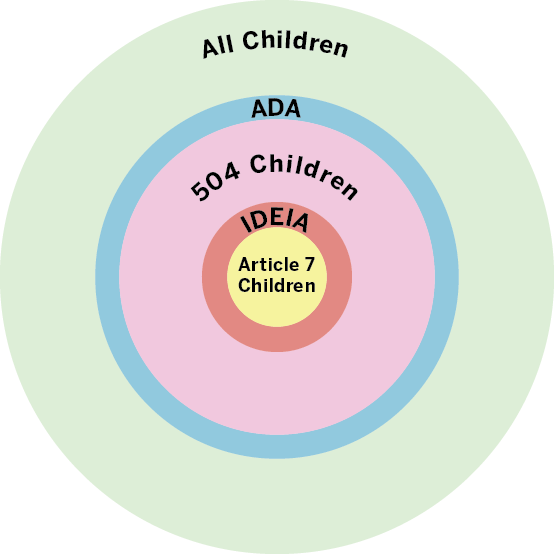Section 4: Rights and Regulations
154 General Overview of ADA, Section 504, IDEIA, and Article 7
IDEIA
The Individuals with Disabilities Education Improvement Act (commonly referred to as IDEA ’04) -enacted in 1975 and recently reauthorized in 2004 – mandated that each state provide all eligible children with a free and appropriate public education that meets his or her unique individual needs. IDEA serves eligible students from the ages of 3 through 21. The law was amended for improvements through the Every Student Succeeds Act (ESSA) in December 2015.
Article 7 is Indiana’s state-level interpretation of IDEIA. The state must minimally meet national guidelines but can go over federal requirements if choosing to do so (e.g., federal requirement for transition planning is 16 years of age; 14 years of age in Indiana).
Americans with Disabilities Act (ADA)
The ADA ensures that an individual with a disability is not discriminated on the basis of the disability in five title areas: Employment, state and local government, public accommodations, commercial facilities, transportation, and telecommunications.
In order to be protected by the ADA, a person must have a disability or have an association with an individual with a disability. An individual with a disability is defined by the ADA as “a person who has a physical or mental impairment that substantially limits one or more major life activities; a person who has a history or record of such an impairment; or a person who is perceived by others as having such an impairment”. The ADA does not specifically name all of the impairments that are covered.
504
Section 504 is similar to ADA in that it prohibits discrimination on the basis of a disability. This covers qualified students with disabilities who attend schools receiving federal financial assistance. All public and private schools that receive federal funds are required to comply with Section 504.
The Americans with Disabilities Act of 1990 (ADA), Individuals with Disabilities Education Improvement Act of 2004 (IDEIA), and Section 504 of the Rehabilitation Act of 1973 represent three attempts to provide assistance, improve access, and prohibit discrimination for those with acute or chronic disabilities. The diagram reflects the level of protection and service available to children under these acts while the following chart represents highlights of these acts:
Levels of Protection & Support

Resources
- Indiana Department of Education. Laws and Resources
https://www.doe.in.gov/specialed/laws-and-resources - Indiana Disability Rights
https://www.in.gov/idr/ - Job Accommodation Network: ADA Library
https://askjan.org/ADA-Library.cfm - Office of Civil Rights. Protecting Students with Disabilities
https://www2.ed.gov/about/offices/list/ocr/504faq.html - U.S. Equal Opportunity Employment Commission. Notice Concerning the Americans with Disabilities Act (ADA) Amendments Act of 2008.
https://www.eeoc.gov/statutes/notice-concerning-americans-disabilities-act-ada-amendments-act-2008 - U.S. Department of Education. Americans with Disabilities Act (ADA).
https://www2.ed.gov/about/offices/list/ocr/docs/hq9805.html - U.S Department of Justice (2005). A Guide to Disability Rights Law.
https://www.ada.gov/cguide.htm
